The Samsung 960 EVO (1TB) Review
by Billy Tallis on November 15, 2016 10:00 AM ESTAnandTech Storage Bench - The Destroyer
The Destroyer is an extremely long test replicating the access patterns of very IO-intensive desktop usage. A detailed breakdown can be found in this article. Like real-world usage and unlike our Iometer tests, the drives do get the occasional break that allows for some background garbage collection and flushing caches, but those idle times are limited to 25ms so that it doesn't take all week to run the test.
We quantify performance on this test by reporting the drive's average data throughput, a few data points about its latency, and the total energy used by the drive over the course of the test.
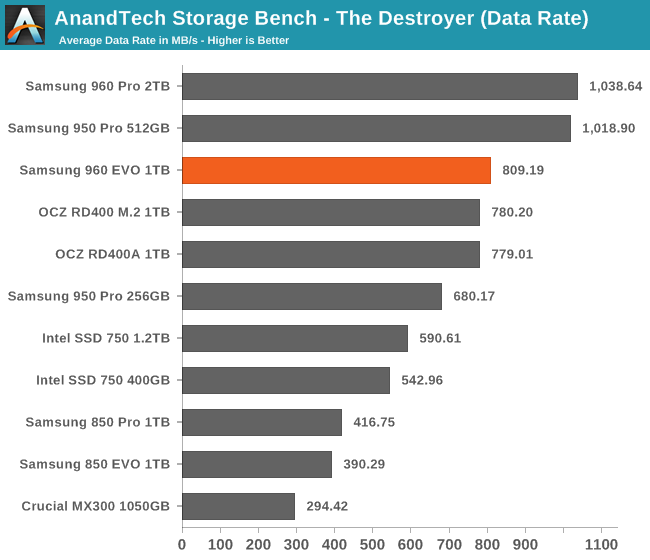
The 960 EVO is substantially slower than both the 950 Pro and 960 Pro, but the 960 EVO is faster than the flagship SSDs from Toshiba and Intel.
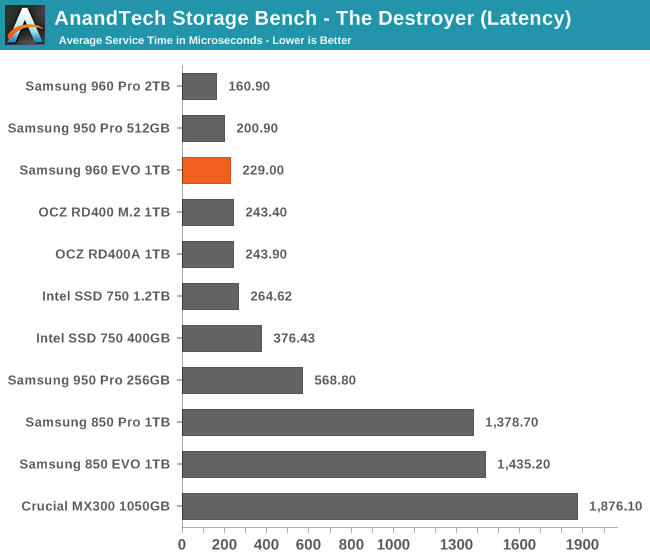
The 960 EVO delivers average service times on par with other high-end PCIe SSDs, and is still slightly faster than any non-Samsung drive.
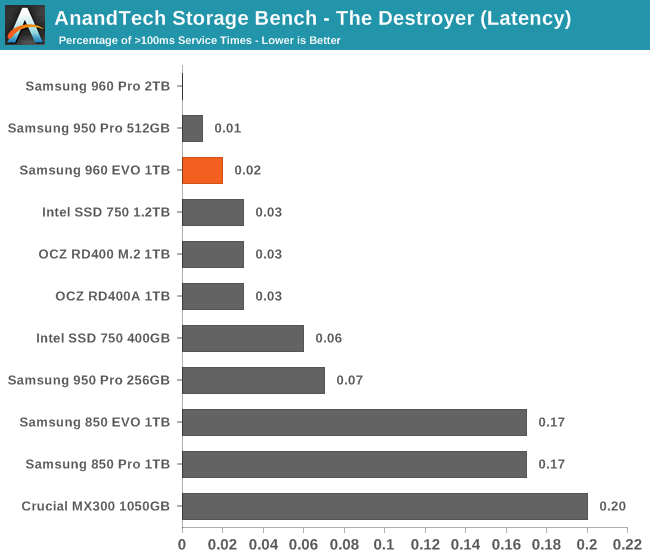
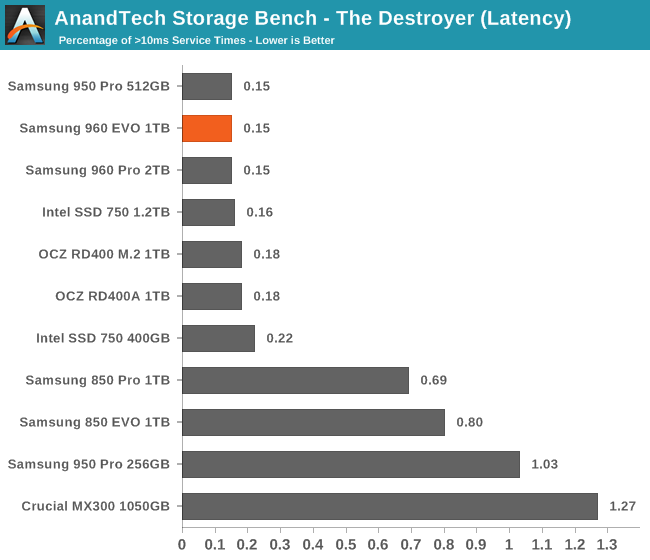
In the frequency of high-latency outliers, the 960 EVO is surpassed only by Samsung's 950 Pro and 960 Pro.
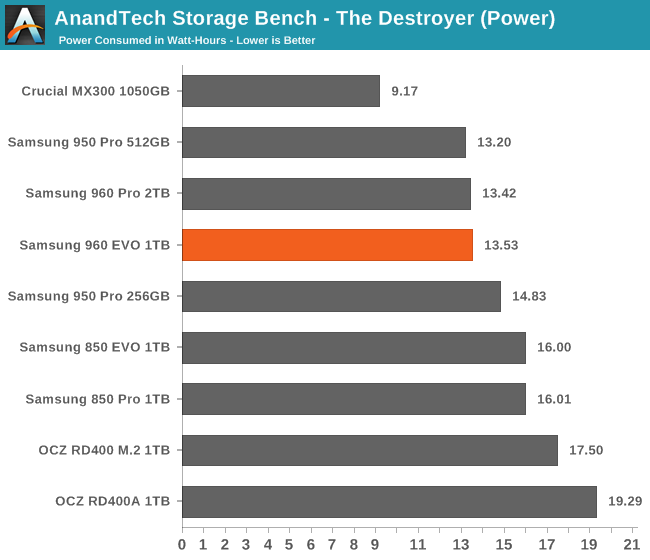
Despite using TLC NAND, the 960 EVO manages comparable power efficiency to the 960 Pro, putting it ahead of the fastest SATA drives but still drawing substantially more power than the most efficient SATA SSDs.










87 Comments
View All Comments
DanNeely - Tuesday, November 15, 2016 - link
The Intel 750 doesn't have power data in Bench. My guess would be that the current power benchmarks post-date when the review sample was returned.Sometimes there are oversights, but most of the time when some devices are only shown in a subset of the charts its because data to score them on the others isn't available. Most often due to moving testsuite targets or breaking changes in the benchmark applications.
http://www.anandtech.com/bench/SSD15/1440
http://www.anandtech.com/bench/product/1458
Billy Tallis - Tuesday, November 15, 2016 - link
Yeah, the Intel 750 was tested by Kristian before we had working PCIe power measurement. It also complicates things by using both the 12V and 3.3V rails, when I only have one meter. Adding power consumption data isn't a high priority for me, because the Intel 750 is always in last place, by a lot: its idle power is higher than the load power of most M.2 drives on many of the tests. The Intel 750 would distort the scale of the power graphs to the point that it would be hard to see the differences between the M.2 drives.willis936 - Tuesday, November 15, 2016 - link
How are M.2 drives mounted during these reviews? Do you use the motherboard's M.2 connector? A PCIe adapter without a heatsink? A PCIe adapter with a heatsink?Billy Tallis - Tuesday, November 15, 2016 - link
Unless otherwise specified, M.2 PCIe drives are tested in a simple Lycom DT-120 adapter, which is connected to the riser card used for power measurement, which is in turn connected to the primary PCIe 3.0 x16 slot. Drives like the OCZ RD400A and Plextor M8PeY are also tested in their bundled adapter cards with whatever heatsink that provides, and any other M.2+heatsink results I report are using the Angelbird Wings PX1 adapter and heatsink.R3MF - Tuesday, November 15, 2016 - link
Is that v2.0 driver available on day one?(for Windows7 users wanting to do a fresh install)
CrazyElf - Tuesday, November 15, 2016 - link
First, it is the drive that will likely play a role in making M.2 SSDs a much more popular form factor, perhaps to the point where NVMe drives overtake SATA. Most people do not need the write endurance that the MLC SSDs have.Second, the performance is quite good, and although there is still a huge price premium over SATA SSDs, the massive performance increase is much more justifiable in terms of cost premium compared to say, the 960 Pro, which is for people who want the best. It will remain that way, until the 970 Pro and Evo come out, or perhaps until a 3D XPoint SSD comes out.
Third, I expect an enterprise version to come out too, with power loss protection. The only real issue i see is if there is something like the 840 Evo that caused performance drops, but so far Samsung's TLC drives since then have been solid.
TheinsanegamerN - Tuesday, November 15, 2016 - link
I believe the 840 evo was planar NAND, whereas the newer designs are 3D NAND. That may be part of the reason.XabanakFanatik - Tuesday, November 15, 2016 - link
I see no mention of Samsung's silent delays of these drives. As of now most models of both the pro and evo are listed as ship by late December or January.Kind of disappointing you would gloss over a 2-3 month delay like that.
haukionkannel - Tuesday, November 15, 2016 - link
It seems that Samsung was lucky that their 250GB unit did fail...http://www.tomshardware.com/reviews/samsung-960-ev...
It seems to completely another series than 1Tb version.
TheinsanegamerN - Tuesday, November 15, 2016 - link
What are you trying to say here?